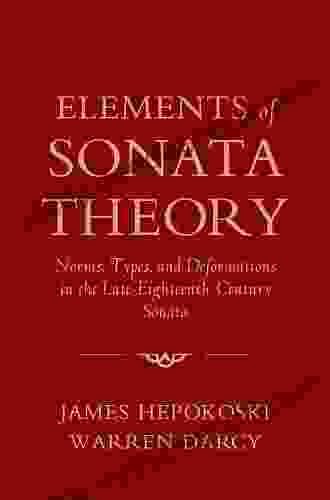The Essential Elements of Sonata Theory: A Comprehensive Guide

4.9 out of 5
| Language | : | English |
| File size | : | 19808 KB |
| Text-to-Speech | : | Enabled |
| Screen Reader | : | Supported |
| Enhanced typesetting | : | Enabled |
| Print length | : | 691 pages |
| Lending | : | Enabled |
Sonata theory is a fundamental aspect of classical music, providing a framework for the organization and development of musical ideas. This article presents a comprehensive overview of the elements of sonata theory, including:
- Sonata Form
- Exposition
- Development
- Recapitulation
- Coda
- Themes
- Modulation
- Key Relationships
- Harmonic Progressions
Sonata Form
Sonata form is a musical structure that is commonly used in classical music, particularly in sonatas, symphonies, and concertos. It consists of three main sections: the exposition, development, and recapitulation.
The exposition introduces the main themes of the sonata. It is typically divided into two parts: the first theme group and the second theme group. The first theme group is usually in the tonic key, while the second theme group is usually in a contrasting key.
The development section is the middle section of the sonata form. It provides a contrasting section to the exposition, and it often develops and transforms the themes that were introduced in the exposition.
The recapitulation is the final section of the sonata form. It is similar to the exposition, but it is typically in the tonic key. The recapitulation restates the main themes of the sonata, and it often provides a sense of closure.
Exposition
The exposition is the first section of the sonata form. It introduces the main themes of the sonata. It is typically divided into two parts: the first theme group and the second theme group.
The first theme group is usually in the tonic key. It often begins with a strong, melodic theme. The first theme group may also include other themes, such as a contrasting theme or a bridge theme.
The second theme group is usually in a contrasting key. It often begins with a more lyrical, flowing theme. The second theme group may also include other themes, such as a contrasting theme or a bridge theme.
Development
The development section is the middle section of the sonata form. It provides a contrasting section to the exposition, and it often develops and transforms the themes that were introduced in the exposition.
The development section may use a variety of techniques to develop and transform the themes. These techniques may include modulation, harmonic progressions, and contrapuntal textures.
The development section may also introduce new material. This new material may be used to develop and transform the themes, or it may be used to provide contrast.
Recapitulation
The recapitulation is the final section of the sonata form. It is similar to the exposition, but it is typically in the tonic key. The recapitulation restates the main themes of the sonata, and it often provides a sense of closure.
The recapitulation may be exact or varied. An exact recapitulation restates the themes exactly as they were presented in the exposition. A varied recapitulation may make changes to the themes, such as changing the key, the instrumentation, or the orchestration.
Coda
The coda is an optional section that may be added to the end of a sonata form movement. It typically provides a final statement of the main themes of the sonata, and it often provides a sense of closure.
The coda may be short or long. A short coda may simply restate the main themes of the sonata. A long coda may develop and transform the main themes, or it may provide new material.
Themes
Themes are the basic building blocks of sonata form. They are typically melodic ideas that are used to develop and transform the sonata.
Themes may be simple or complex. Simple themes may consist of a single melodic line. Complex themes may consist of multiple melodic lines, and they may use a variety of harmonic progressions and contrapuntal textures.
Themes may also be contrasting or related. Contrasting themes are themes that have different melodic, harmonic, and rhythmic characteristics. Related themes are themes that share similar melodic, harmonic, and rhythmic characteristics.
Modulation
Modulation is the process of changing from one key to another. It is a common technique that is used in sonata form to provide contrast and to develop and transform the themes.
Modulation may be sudden or gradual. Sudden modulation is a change from one key to another without any preparation. Gradual modulation is a change from one key to another that is prepared by a series of harmonic progressions.
Modulation may be used to create a variety of effects. It may be used to provide contrast, to develop and transform the themes, or to create a sense of tension and release.
Key Relationships
Key relationships are the relationships between different keys. They are used in sonata form to create a sense of unity and coherence.
The most common key relationships in sonata form are the tonic key, the dominant key, and the subdominant key. The tonic key is the key that is used at the beginning and end of the sonata. The dominant key is the key that is a fifth above the tonic key. The subdominant key is the key that is a fifth below the tonic key.
Other key relationships may also be used in sonata form. These key relationships may be used to create contrast, to develop and transform the themes, or to create a sense of tension and release.
Harmonic Progressions
Harmonic progressions are sequences of chords that are used to create a sense of movement and direction. They are a common technique that is used in sonata form to develop and transform the themes.
Harmonic progressions may be simple or complex. Simple harmonic progressions may consist of a single chord progression. Complex harmonic progressions may consist of multiple chord progressions, and they may use a variety of harmonic techniques, such as modulation, chromaticism, and dissonance.
Harmonic progressions may be used to create a variety of effects. They may be used to provide contrast, to develop and transform the themes, or to create a sense of tension and release.
Sonata theory is a fundamental aspect of classical music. It provides a framework for the organization and development of musical ideas. The elements of sonata theory, such as form, themes, modulation, and harmonic progressions, are used to create a sense of unity, coherence, and contrast.
Sonata theory is a complex subject, but it is essential for understanding the structure and development of classical music. By understanding the elements of sonata theory, you can gain a deeper appreciation for the beauty and complexity of classical music.
4.9 out of 5
| Language | : | English |
| File size | : | 19808 KB |
| Text-to-Speech | : | Enabled |
| Screen Reader | : | Supported |
| Enhanced typesetting | : | Enabled |
| Print length | : | 691 pages |
| Lending | : | Enabled |
Do you want to contribute by writing guest posts on this blog?
Please contact us and send us a resume of previous articles that you have written.
 Book
Book Novel
Novel Chapter
Chapter Genre
Genre Reader
Reader Library
Library Paperback
Paperback E-book
E-book Magazine
Magazine Newspaper
Newspaper Sentence
Sentence Shelf
Shelf Glossary
Glossary Foreword
Foreword Preface
Preface Footnote
Footnote Scroll
Scroll Codex
Codex Bestseller
Bestseller Library card
Library card Narrative
Narrative Biography
Biography Autobiography
Autobiography Encyclopedia
Encyclopedia Dictionary
Dictionary Thesaurus
Thesaurus Card Catalog
Card Catalog Archives
Archives Periodicals
Periodicals Lending
Lending Academic
Academic Journals
Journals Reading Room
Reading Room Rare Books
Rare Books Special Collections
Special Collections Study Group
Study Group Dissertation
Dissertation Storytelling
Storytelling Book Club
Book Club Theory
Theory Mark Victor Hansen
Mark Victor Hansen Christian Davenport
Christian Davenport M J Rose
M J Rose Vedran Deletis
Vedran Deletis Sudip Tarafdar
Sudip Tarafdar Toby Neighbors
Toby Neighbors Shohreh Ghasemi
Shohreh Ghasemi Shawna Yang Ryan
Shawna Yang Ryan Ankit Kirar
Ankit Kirar Elayne Savage
Elayne Savage Brandy Woods Smith
Brandy Woods Smith Jerrold Lerman
Jerrold Lerman Richard Carman
Richard Carman Bryan Wagner
Bryan Wagner Chana Levitan
Chana Levitan C K Prahalad
C K Prahalad Annabel Chase
Annabel Chase Tim Baker
Tim Baker Storyshopusa
Storyshopusa Stian Rice
Stian Rice
Light bulbAdvertise smarter! Our strategic ad space ensures maximum exposure. Reserve your spot today!

 Glen PowellValue-Based Strategy for Capital Equipment Companies: Redefining Success in a...
Glen PowellValue-Based Strategy for Capital Equipment Companies: Redefining Success in a... Robin PowellFollow ·7.7k
Robin PowellFollow ·7.7k Diego BlairFollow ·15.1k
Diego BlairFollow ·15.1k Jim CoxFollow ·10.1k
Jim CoxFollow ·10.1k Craig BlairFollow ·19.8k
Craig BlairFollow ·19.8k Gavin MitchellFollow ·14.7k
Gavin MitchellFollow ·14.7k Enrique BlairFollow ·17.3k
Enrique BlairFollow ·17.3k Jacques BellFollow ·15.1k
Jacques BellFollow ·15.1k Robert HeinleinFollow ·5.8k
Robert HeinleinFollow ·5.8k

 Dominic Simmons
Dominic SimmonsIcky Island: An Unforgettable Adventure for Kids!
Introducing Icky Island: A Delightful One...

 Carlos Fuentes
Carlos FuentesThe Midnight Breed: Embracing the Shadows and Unlocking a...
Welcome to the captivating world of...

 Ike Bell
Ike BellTwelve Steps Toward Political Revelation: A Path to...
Politics, often perceived as a complex and...

 Cameron Reed
Cameron ReedTravels in Arizona Goldfield: Unraveling the Threads of...
Nestled amidst the rugged...

 John Grisham
John GrishamFlashpoints of Cinema History and Queer Politics:...
The relationship between cinema history and...
4.9 out of 5
| Language | : | English |
| File size | : | 19808 KB |
| Text-to-Speech | : | Enabled |
| Screen Reader | : | Supported |
| Enhanced typesetting | : | Enabled |
| Print length | : | 691 pages |
| Lending | : | Enabled |












